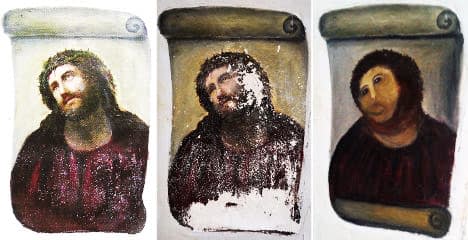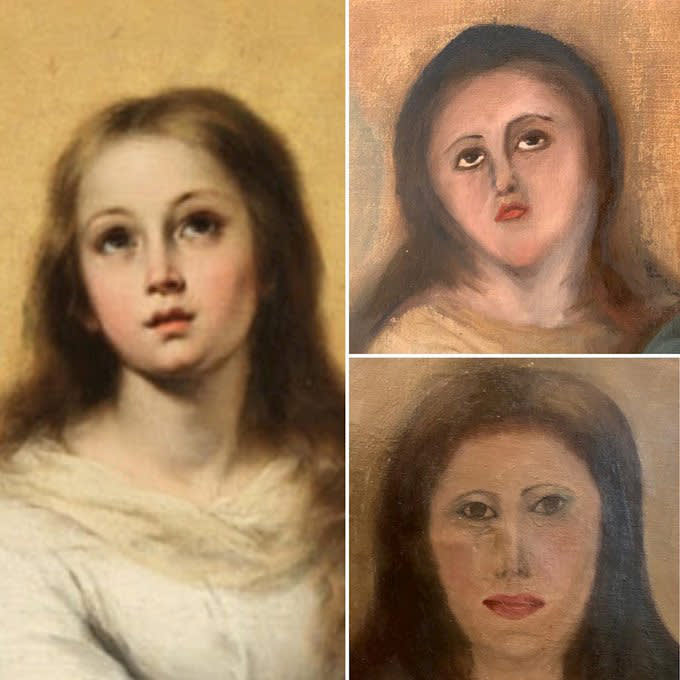Why Does Spain Keep Destroying Its Beautiful Art?

Spain is in the news again for all the wrong reasons, and conservationists around the globe are shaking their fists. A photo has surfaced of what could be the country’s sloppiest restoration to date: the carving of a once-delicate shepherdess’s face now mangled beyond repair, with lopsided sockets for eyes, an outsize zit for a nose, and a toothless dent for a mouth. Locals in Palencia, north of Madrid, have dubbed her “Potato Head.”
This is déjà vu for Spaniards. Earlier this year, the world gasped when a botched refurbishment of Murillo’s Immaculate Conception of Los Venerables came to light bearing no resemblance to the Baroque original. In 2018, a 16th-century statue of St. George was retouched so badly—evidently by a school teacher in Navarra—that it resembled a toy soldier. And it’s hard to unsee Spain’s most infamous bungle, “Ecce Mono” aka “Monkey Christ,” a 90-year-old fresco of Jesus rendered into a menacing primate-esque blob. The list goes on and on.
The litany of screwups begs the question: Why does this keep happening in Spain, and what is to blame?
When Antonio Capel heard that something looked off about the Unicaja building in the center of Palencia, he didn’t think much of it. The painter had walked by the neo-renaissance façade hundreds of times and never noticed anything amiss. But when he got a closer look, his jaw dropped: Was the bungled face staring back at him a restoration gone wrong? A prank? A publicity stunt? In disbelief, he posted a photo of the sculpture on Facebook.
Social media did its thing. Within days, the “Potato Head of Palencia” was plastered on art forums and international news websites. Twitter and Reddit ate it up: The before and after pics were promptly memeified into “How it started/How it’s going” jokes.
The artistic community was less amused. Spain’s Professional Association of Restorers and Conservators (ACRE) released a blistering two-page statement on Nov. 13 regarding the Palencia statue. “These are NOT restorations,” it said, but rather “harmful acts carried out by people who are not professionals in conservation-restoration.”

"Monkey Christ"
In Palencia, the question on everyone’s mind is: who done it? According to the city’s head press officer, Julián García, we may never know. García explained in a phone interview that the building was renovated in the early ’90s to make way for private apartments. A construction worker at that time likely took it upon him or herself to “fix” the facial features that had eroded over the years. “We can’t be sure about the when or the who. All we know is, that face has been there for many, many years,” he said, adding that there’s no record of what company undertook the refurbishment.
In fact, nobody even knows who the original sculptor of the façade is. An exhaustive article about the building’s inauguration in 1923 detailing its technical and architectural elements makes no mention of the sculptures on the façade, according to García. “So we’re not talking about artistic heritage or a masterpiece by Mariano Benlliure here,” he said, referencing the renowned Spanish sculptor. “The façade has been an afterthought from the moment the building went up.”
Zach Tatti is co-owner of Tatti Art Conservation in New York City, which has undertaken such ambitious restorations as Cleopatra’s Needle in Central Park and the Statue of Liberty. He has a different view. “Creating a building of that size and scale in the 1920s with those sculptural elements is a feat considering the technology of the time,” he said over the phone. “The façade tells a story of the craftsmen of the era, and it should have been treated with the utmost care.”
Even if one were to concede that the shepherdess was no masterpiece to begin with, and therefore no great loss, what is Spain’s excuse for the profusion of bad restorations of culturally significant works? The president of ACRE, Francisco Manuel Espejo Jiménez, explained in an email that while botches occur everywhere, Spain seems especially plagued by them in part because Spaniards denounce them more often and more vociferously than other countries do, creating the illusion of more occurrences. And because the media are (unfortunately) used to covering botched renovations in Spain, sourced stories can be slapped up in no time.

Immaculate Conception of Los Venerables
Compared to other countries, Spain also holds vast quantities of art, much of it in dwindling towns with scant financial resources. As anyone who’s traveled to Spain knows, nearly every village has a historical church containing religious works—works that necessitate periodic restoration. So, what happens when a statue is crumbling and there’s no budget to hire a professional conservator? The local contractor gets called in, and things get messy.
But most importantly, there’s a conspicuous lack of regulation and oversight: “In Spain, the profession of conservator-restorer [...] is not regulated by law,” he said, referring to a sclerotic 1985 Historical Heritage resolution. In other words, any amateur artist can be hired for restorations. “It’s a grave danger for our heritage,” he said.
This being Europe, there’s also plenty of bureaucratic hot potato when it comes to determining what agency is responsible for a given restoration and what qualifies as artistic heritage to begin with. The intricacies here are yawn-inducing, but suffice to say that some works fall under the care of the national heritage foundation (Patrimonio Nacional), while others are presided over by the Ministry of Culture, local governments, and other public and private entities.
Where does the buck stop, then, regarding the shepherdess? At Palencia’s city hall, according to Espejo Jiménez. The local government “supervises the conservation of these kinds of properties, so it should be they who give [restoration] approvals and permits.” As Palencia’s press rep noted, the “restoration” of the shepherdess and the building at large didn’t go through those channels, exposing a severe lack of oversight that the city must reckon with.
The irony, of course, is that to remedy a botched restoration, one has to to hire a restorer to re-restore. That’s what the Palencia building’s tenants association plans on doing, according to a Spanish news report. To the chagrin of some locals, the city may miss out on tens of thousands of tourists, but in turn, it will keep its artistic integrity. Works start in the spring.
From the moment Capel posted the image of the defaced shepherdess, much energy has been spent on head-shaking and finger-pointing. But all the noise belies an uncomfortable truth: That ugly face sat for over a decade on Palencia’s main drag—and nary a soul noticed. (And yet, we’re outraged now?)
Palencia’s Potato Head debacle is a wake-up call to appreciate and protect the subtler works of art that make day-to-day life more interesting. Until those values are reflected in policy in Spain, the crimes against fine art will continue.
Get our top stories in your inbox every day. Sign up now!
Daily Beast Membership: Beast Inside goes deeper on the stories that matter to you. Learn more.

 Yahoo Finance
Yahoo Finance 